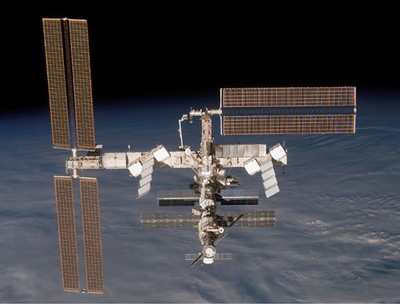Sat, Mar 17, 2007
Station Hits Lowest Average Altitude In History Of Project
Say... is that bright light in the sky getting closer? If you're
looking at the International Space Station... why yes, it is. But
NASA says there's no reason panic.

MSNBC reports NASA's tracking data shows the nine-year-old
station's orbital path has slipped to just 207 miles above the
Earth, its lowest average altitude ever. Rocket burns meant to send
the station into a higher orbit -- such as the series carried out
this week, using the engine of a docked Russian Progress module --
have resulted in only slight improvements.
The station has been falling since its first components were
placed in low-earth-orbit back in 1998, due to constant atmospheric
drag. But the decline took a noticeable dip in 2003, when NASA
grounded its space shuttle fleet following the loss of Columbia.
Visiting shuttles had been able to give sizable reboosts to the
station; since 2003, however, such firings have been done by the
much smaller Russian capsules.
NASA maintains the station's orbit is stable, and the Russian
firings are enough to keep the station from slipping ever closer to
Earth. Once larger components of the station are delivered and
installed by the space shuttle next year, the orbiters will resume
the primary responsibility for correcting the station's orbit.
"Our altitude is driven by shuttle rendezvous altitude limits,"
said Mission Control expert Ainsley Collins, who along with her
Russian counterpart helps coordinate reboost firings, and other
maneuvers.
"The lowest the station orbit has ever been was on May 23,
2000," Collins recalled, when the station reached its lowest point
after dropping 43 miles from a high orbit of 250 miles. A shuttle
then pushed the station higher... and over the next two years, the
station remained relatively stable at around 246 miles. Then the
slide began.
Collins added the boosts are barely noticeable to the station's
crew. The force produced by Thursday's 12.5-minute firing of the
Progress module's manuevering rockets only resulted in about .5 g's
of pull.
More News
Light Gun A handheld directional light signaling device which emits a brilliant narrow beam of white, green, or red light as selected by the tower controller. The color and type of>[...]
"The journey to this achievement started nearly a decade ago when a freshly commissioned Gentry, driven by a fascination with new technologies and a desire to contribute significan>[...]
Aero Linx: JAARS, Inc. For decades now, we’ve landed planes on narrow rivers and towering mountains. We’ve outfitted boats and vehicles to reach villages that rarely se>[...]
"Our driven and innovative team of military and civilian Airmen delivers combat power daily, ensuring our nation is ready today and tomorrow." Source: General Duke Richardson, AFMC>[...]
Aircraft Conflict Predicted conflict, within EDST of two aircraft, or between aircraft and airspace. A Red alert is used for conflicts when the predicted minimum separation is 5 na>[...]
 ANN's Daily Aero-Term (04.20.24): Light Gun
ANN's Daily Aero-Term (04.20.24): Light Gun Aero-News: Quote of the Day (04.20.24)
Aero-News: Quote of the Day (04.20.24) ANN's Daily Aero-Linx (04.21.24)
ANN's Daily Aero-Linx (04.21.24) Aero-News: Quote of the Day (04.21.24)
Aero-News: Quote of the Day (04.21.24) ANN's Daily Aero-Term (04.21.24): Aircraft Conflict
ANN's Daily Aero-Term (04.21.24): Aircraft Conflict



